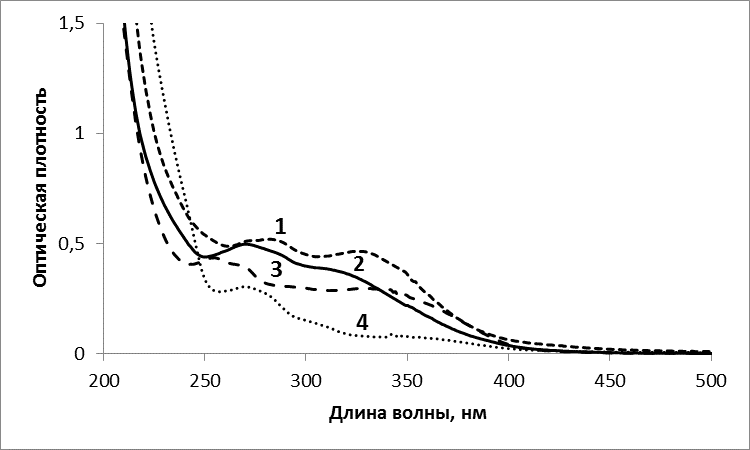UV-SPECTROMETRY AND THE LIPID COMPOSITION OF THE WATER-PROPYLENEGLYCOL EXTRACTS FROM SEVERAL HERBS
UDC 577.13: 544.02: 633.88
Abstract
The physico-chemical properties by means of UV-spectroscopy and the lipid composition of extracts from Salvia officinalis L. leaves, the Calendula officinalis L and Matricaria chamomilla L. flowers; Hippophoe rhamnoides L fruits were studied. It is shown that extracts characterized the low shares of phospholipids and a trace content of sterols in the total lipid composition. Extracts studied are in the following sequence in accordance with decreasing the phospholipid share in the total lipid composition: Salvia officinalis L. leaves > Calendula officinalis L flowers = Hippophoe rhamnoides L fruits > Matricaria chamomilla L. flowers. It is shown that the quantitative ratio of phospholipid fractions is determined by the nature of the plant. Thus, the highest relative content of the phospholipid lysoforms in extracts was found in Calendula officinalis L flowers and Hippophoe rhamnoides L fruits, the highest share of sphingolipids was revealed in phospholipids of Calendula officinalis L and Matricaria chamomilla L flower extracts, and the phospholipids of Hippophoe rhamnoides L fruit extracts contained the highest amount of phosphatidylcholine. The high content of the more easily oxidizable fractions in the phospholipid composition especially for Salvia officinalis L. leaves are revealed. Using UV-spectrometry of extracts and mathematical analysis of these data the presence of flavonoids with different chemical structure is confirmed.
Downloads
Metrics
References
Stoyanova A., Stankova D., Dilcheva M., Daminova S., Dimitrov M. Izvestiya VUZOV. Pishchevaya tekhnologiya, 2002, no. 4, pp. 74–75 (in Russ.).
Amel'chenko V.Ye., Boltovskiy V.S., Bondarenko Zh.V. Viesci nacyjanaĺnaj akadiemii navuk Bielarusi. Sier. chim. navuk, 2016, no. 1, pp. 88–93 (in Russ.).
Yevseyeva S.B., Sysuyev B.B. Farmatsiya i farmakologiya, 2016, no. 3, pp. 4–37. DOI: 10.19163/2307-9266-2016-4-3-4-37 (in Russ.).
Ushanova V.M., Voronin V.M., Repyakh S.M. Khimiya rastitel'nogo syr'ya, 2001, no. 3, pp. 105–110 (in Russ.).
Braslavskiy V.B., Kurkin V.A. Meditsinskiy al'manakh, 2011, no. 2, pp. 140–144. DOI: 10.30906/0023-1134-2008-42-9-43-48. (in Russ.).
Semenistaya V.I., Larionov O.G. Khimiko-farmatsevticheskiy zhurnal, 2008, vol. 42, no. 9, pp. 43–48 (in Russ.).
Fenol'nyye soyedineniya: svoystva, aktivnost', innovatsii: sbornik nauchnykh statey po materialam X Mezhdu-narodnogo simpoziuma «Fenol'nyye soyedineniya: fundamental'nyye i prikladnyye aspekty» [Phenolic compounds: properties, activity, innovation: a collection of scientific articles based on the materials of the X International Symposium “Phenolic compounds: fundamental and applied aspects”], ed. N.V. Zagoskina. Moscow, 2018, 625 p. (in Russ.).
Volkov V.A., Li Yu.S., Voronkov M.V., Lapina G.P., Misin V.M. Syr'ye i upakovka, 2017, no. 8 (195), pp. 42–44 (in Russ.).
Volkov V.A., Li Yu.S., Voronkov M.V., Lapina G.P., Zav'yalov A.Yu., Misin V.M. Aktual'nyye voprosy biol. fiziki i khimii, 2018, vol. 3, no. 3, pp. 630–635 (in Russ.).
Gennis R. Biomembrany: molekulyarnaya struktura i funktsii. [Biomembranes: molecular structure and functions]. Moscow, 1997, 624 p. (in Russ.).
Tarkhovskiy Yu.S., Kim Yu.A., Abdrasilov B.S., Muzafarov Ye.N. Flavonoidy: biokhimiya, biofizika, meditsina. [Flavonoids: biochemistry, biophysics, medicine]. Pushchino: Synchrobook, 2013, 310 p. (in Russ.).
Mazaletskaya L.I., Sheludchenko N.I., Shishkina L.N. Prikladnaya biokhimiya i mikrobiologiya, 2010, vol. 46, no. 2, pp. 148–152 (in Russ.).
Mazaletskaya L.I., Sheludchenko N.I., Shishkina L.N. Chemistry and Chem. Technology, 2012, vol. 6, no. 1, pp. 35–41.
Keyts M. Tekhnika lipidologii. [Technique of lipidology]. Moscow, 1975, 322 p. (in Russ.).
Biologicheskiye membrany: metody [Biological membranes: methods], ed. Dzh.B.S. Findley, V.Kh. Evanz. Moscow, 1990, 423 p. (in Russ.).
Shishkina L.N., Kushnireva Ye.V., Smotryaeva M.A. Oxidation Commun., 2001, vol. 24, no. 2, pp. 276–286.
Sperry W.M., Webb M. J. Biol. Chem., 1950, vol. 187, pp. 97–106.
Brin E.F., Travin S.O. Khimicheskaya fizika, 1991, vol. 10, no. 6, pp. 830–837 (in Russ.).
Botirov E.KH., Karimov A.N., Drenin A.A. Flavonoidy rasteniy roda Scutellaria L. [Flavonoids of plants of the genus Scutellaria L]. Surgut, 2016, 146 p. (in Russ.).
Sharova O.V., Kurkin V.A. Khimiya rastitel'nogo syr'ya, 2007, no. 1, pp. 65–68 (in Russ.).

Copyright (c) 2020 Khimiya Rastitel'nogo Syr'ya (Chemistry of plant raw material)

This work is licensed under a Creative Commons Attribution 4.0 International License.

This work is licensed under a Creative Commons Attribution 4.0 International License.
The authors, which are published in this journal, agree to the following conditions:
1. Authors retain the copyright to the work and transfer to the journal the right of the first publication along with the work, at the same time licensing it under the terms of the Creative Commons Attribution License, which allows others to distribute this work with the obligatory indication of the authorship of this work and a link to the original publication in this journal .
2. The authors retain the right to enter into separate, additional contractual agreements for the non-exclusive distribution of the version of the work published by this journal (for example, to place it in the university depository or to publish it in a book), with reference to the original publication in this journal.
3. Authors are allowed to post their work on the Internet (for example, in a university repository or on their personal website) before and during the review process of this journal, as this may lead to a productive discussion, as well as more links to this published work.











